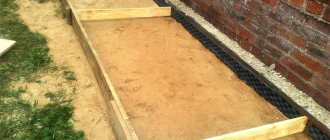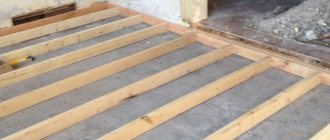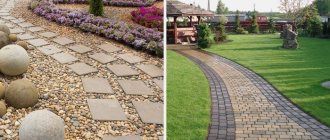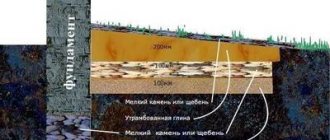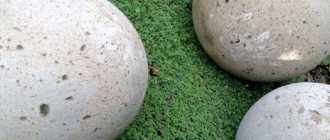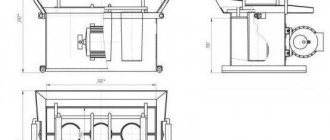Garden areas look more impressive and well-groomed with paths equipped in different ways.
The most common method of arrangement is concreting paths, which can easily be done with your own hands. Concrete paths are the most practical and durable, and modern decorative elements will help give the concrete surface a special elegance.
A concrete path can be an excellent decorative element in your garden.
No. 1. What are the benefits of concrete paths?
Before installing concrete paths on your site, you need to know about all the advantages and disadvantages. The main advantages of paths made of concrete include:
- ease of installation, you can do everything yourself without the help of specialists;
- low price (compared to other options);
- the ability to manufacture any shapes and sizes if appropriate formwork is available;
- extensive decoration possibilities (adding pigment to the solution, using stone, mosaics and other decorations);
- strength and durability;
- resistance to the harmful effects of the environment (moisture, frost, etc.).
Among the disadvantages are:
- lack of possibility of redevelopment. Since this is a capital structure and it will be practically impossible to change the direction after the completion of the work, it is necessary to plan in advance both the structure itself and the entire surrounding area;
- the complexity of the preparatory work. In order for the design to be truly high-quality and reliable, you will need to put in enough effort and spend a lot of time preparing materials;
- occurrence of cracks. Sometimes in the off-season, soil shifts can occur, as a result of which the concrete structure can gradually collapse, including due to temperature changes.
If we compare concrete paths with other options in terms of advantages and ease of arrangement, then they win in many ways. Related to this is the desire to independently organize such trails on the site. Where to start and what to consider?
Do-it-yourself concreting of paths at the dacha using continuous pouring method
Primary preparation is carried out as described above - marking, removing soil from the trench, backfilling and compaction. Next you need to install the formwork.
This is easiest to do for a straight path.
To prevent the pressure of the mixture from overturning the formwork boards, it is necessary to install support stakes in increments of at least 1 m. The struts are placed in those places where the formwork boards are connected.
For curved contours, it is necessary either to bend the boards, which is not always possible, or to use other plate materials - for example, thick elastic plastic, sheet metal.
If it is necessary to clearly maintain the coincidence of the centers of the bending radius of the track on the outer and inner sides, it makes sense to use ties. The tension elements must be above the filling level.
Next, the prepared concrete mixture is poured into the installed formwork. The formwork can be removed after the concrete has gained at least 25% of its design strength, and preferably after reaching 50%. It makes no sense to determine deadlines using standard tables intended for large volumes. You can use a moisture meter; its readings should not exceed 50% at the time of removing the formwork.
Important: to increase the strength and durability of a concrete path, it is better to reinforce it. To do this, they use ready-made metal reinforcing mesh, used to strengthen monolithic foundations and floors, as well as self-made reinforcing elements. The reinforcing mesh should not touch the formwork and reach the upper plane of the future; special clamps are used for this. The minimum distance between the extreme points of the reinforcement and the external planes of the track is 1.5...2 cm.
Instead of formwork, you can use the future path fencing. To ensure that it is sufficiently dense and does not allow the relatively liquid concrete mixture to flow outside the fence, it is worth using sheet materials or very carefully mated individual parts.
If the smooth surface of concrete paths does not suit future users, you can use the interesting technology presented in this video to make the concrete mixture that has not yet completely hardened look like paving stones.
Another way to create a relief that imitates stonework is offered by the creators of this master class. A flexible form is used.
No. 3. What tools and materials will be needed?
Before starting work, you should stock up on everything you need, namely:
- cement not lower than grade 300;
- sand;
- crushed stone;
- waterproofing additives for concrete;
- pieces of plywood, boards or metal to create formwork;
- wooden or steel pegs;
- sledgehammer or hammer for hammering in pegs;
- container for mixing the solution;
- a pair of shovels;
- steel construction mesh;
- smoother for leveling the surface of the path;
- trowels and spatulas.
No. 4. How to design a path?
The first thing you need to think about is where the paths will be located, who will move along them and when , what determines their width and shape. On paper, you can draw a site plan, indicate on it the location of all buildings and important areas, connect them with straight lines, which will be the axes for future paths. The paths can remain smooth and straight only between huge beds; in other cases, it is better to make them slightly curved to give the area an interesting look and make movement more comfortable and convenient.
The width of the path that leads from the gate to the central entrance of the house should be about 2 m, for auxiliary paths a width of 0.8-1 m is enough, between the beds you can arrange paths about 0.5 m wide. Those paths along which the car will move , should be no narrower in width than the car itself.
Types of material for filling paths
A concrete path can take several forms. When choosing a design, the following factors are taken into account:
- type of landscape design;
- the purpose of the future path;
- host preferences.
Using Forms
Wear-resistant plastic is used to make tracks. The ready-made solution contains samples that imitate paving stones and paving slabs of different color shades. This is achieved by adding dyes to the cement composition.
Stamped concrete
This material differs from a conventional monolith by the mandatory pressing of the surface. Raw materials can imitate marble, natural stone, wood, decorative brick. A popular solution would be to apply stamps reminiscent of animal tracks or figures.
Tile
Figure 1. Tile path
The product is popular for laying pedestrian areas and vehicle entrances. Paths can look like a square, a wave, a triangle, or have an arbitrary configuration.
Monolith
This choice is the simplest. Cement mortar is poured into a shallow trench onto the prepared base and its surface is leveled.
Colored concrete
To create more vibrant colors in your garden, you can add dyes to concrete. Products must be combined with the solution during mixing. The advantage of this method is the durability of the monolith and the absence of pigment fading. The disadvantage is the high consumption of dye, which increases the cost of the event.
We create a path with our own hands
If you plan to build concrete paths on the site, you need to know exactly how to make them. The main thing is to follow the correct kneading technology.
Trail dimensions
Determining the shape of the path will help give the site an original look and provide conditions for comfortable movement around the territory. The optimal dimensions for the width of the path from the gate to the central entrance of the cottage are about 2 m. If these are auxiliary groups, a width of 0.8–1 m is sufficient. The width of the paths for moving the car must be slightly larger than the dimensions of the car itself.
Materials and tools for concrete walkways
During the work you will need the following equipment and materials:
- fasteners;
- wood for formwork;
- wooden slats;
- hacksaw;
- reinforcement reinforcement;
- tape measure and level;
- rake, usually twine;
- marking pegs;
- concrete mixer;
- materials for obtaining the mixture;
- additives to improve waterproofing;
- sledgehammer.
Site marking
Marking is the beginning of the steps to create paths. To prevent puddles from appearing on the path, it is necessary to provide a slight slope. It is quite enough to have a bevel of 2 mm relative to each meter of the structure. Particularly important is such a slope made across the path, although it must also be provided for in its longitudinal direction. The runoff should be directed to where there is a natural decline in the soil to prevent stagnation of water. It is not advisable to divert water to buildings.
Marking stages:
- Pegs are placed along the perimeter of the path with a step between them of 3–5 m, as well as in the corners;
- make notes;
- A rope is pulled along a given perimeter.
Preparing the base
This type of work includes the following actions:
- remove the top layer of soil with all the plants in it;
- if a “pillow” of sand and concrete is planned, it is made 10 cm high;
- it is better when the path rises 5 cm at ground level;
- choose a recess taking into account these requirements: 10 + 10-5 = 15 cm of soil;
- when drainage is necessary, add 10 cm to this value;
- Use a shovel to select the required layer of soil.
Preparation of the solution
The next activity will be mixing the solution. In addition to the main ingredients, water and plasticizers are added to the mass. The composition is thoroughly mixed so that it has the consistency of sour cream.
For the solution, it is necessary to use crushed stone of medium fractions - 10–20 mm. If you plan to create a path with increased load, then you need a material fraction of at least 40 mm. Plasticizers are added in small quantities. This will allow the mass to be distributed equally throughout the recess. With an excess of this component, the risk of reducing the strength of the concrete grade increases. To create colored tracks, a dye pigment is added to the solution.
Assembling the formwork
The structure can be created from edged boards or thick plywood. The step-by-step guide looks like this:
- place the boards in trenches on a previously prepared base;
- the height of the structure must be equal to the height of the planned path;
- The horizontality of the formwork is checked using a building level;
- sand is poured on top of the compacted bottom, and then crushed stone;
- lay the reinforcing mesh;
- in increments of every 2–2.5 m across the recess, plank lintels are installed, which will take the main load during pouring of the concrete solution.
The formwork structure should rise 10 cm above the soil. When curved paths are planned, it is better to use plywood or plastic panels instead of boards - it is convenient to bend them in the required direction.
Creating a pillow
To evenly distribute the load, a sand cushion is required. It is also a drainage because it allows moisture to pass through, eliminating concrete deformation. It is advisable to first lay waterproofing on the pre-compacted bottom of the trench and then pour sand. The sand filling is thoroughly compacted; it is better to moisten it a little first, and then level it with a rake to remove voids. If the soil is very wet, especially when the temperature drops low in winter, it is recommended to pour a layer of crushed stone on top of the sand - then the concrete will not move away due to soil heaving, and cracks will not appear in it.
We carry out reinforcement
The presence of metal elements in the concrete layer greatly extends its service life; less mortar layer is required. To reduce metal costs, it is recommended to use old wire, pipe scraps, and pieces of mesh. Although the best option is reinforced wire, lined with a mesh with 10*10 cm cells. It is laid in the middle of the trench, fixing the connections with wire. The pouring process
For a path on which only people will move, it is enough to make a five-centimeter layer of concrete. If a large load is expected, it should be doubled. The kneading is done in a ratio of 1:3. First, the cement is mixed dry, adding sand, then slowly pour in water. The poured surface must be compacted until laitance comes out. After the concrete begins to set, any unevenness is eliminated with a spatula.
We design and decorate concrete paths
Figure 2. Examples of paths made of tiles
You should start decorating the path one day after it has been poured. Using a metal rod, ornaments are made on the surface, imitating the contours of the tile. Concrete can also be successfully painted with acrylic paint to make the path bright.
No. 5. How to correctly calculate the weight of building materials?
To avoid having to urgently purchase additional cement or sand during construction work, it is better to at least approximately estimate in advance the amount of materials that will be needed. The layer of concrete in different conditions may differ : for heavy clay soil - 5-7 cm, for sandy and light loamy soil - 10 cm. In addition, if the soil is swampy, then you need to provide a layer of gravel 5 cm thick. In any case, you will need a so-called cushion , which is made of sand and has a thickness of 10-15 cm.
The calculation of all the necessary materials is quite simple. Let's say it is necessary to build a path with a width of W = 1 m, a length of D = 10 m and a thickness of T = 10 cm (0.1 m), and the underlying layer of sand will be equal to P = 0.1 m:
- To organize a sand cushion, the required amount of sand is calculated as W*D*P. In our case, it turns out 1m*10m*0.1m=1m3. According to the reference information, the weight of a cubic meter of sand is 2400 kg, so 2400 kg is needed to complete the underlying layer;
- concrete can be prepared in the proportion of 3 parts sand and 1 part crushed stone, cement and water, but there are other options, which will be discussed later. It is more convenient to first calculate the volume of concrete required using the formula W*L*T, which comes out to 1m*10m*0.1m=1m 3 . According to reference information, the average weight of a cubic meter of concrete is 2800 kg. The resulting weight of the concrete volume can be divided into 5 parts, not taking into account water: 2800/5 = 560 kg - the weight of one part, i.e. cement. The rest 2240 kg is the weight of sand, crushed stone and water. You may also need dyes, plasticizers, water-repellent additives, etc.
Of course, this calculation does not pretend to be strictly mathematically accurate, but it allows you to approximately understand how much and what will be needed.
No. 7. How to prepare the soil?
At this stage, they begin to select the top layer of soil at the trail locations. The soil is removed along with small roots, which can begin to rot and form voids in which water can accumulate, and when it freezes and increases in volume, additional pressure will be exerted on the path.
If the layer of “cushion” of sand is 10 cm, and concrete - 10 cm, then taking into account that it is better for the path to rise 3-5 cm above the ground level , you will need to choose 10 cm + 10 cm - 3 cm = 17 cm of soil. If a drainage layer of gravel is needed, then you need to add another 5-10 cm to the resulting value. Select the soil layer using a shovel.
No. 9. How to arrange a pillow?
The so-called cushion under the concrete path performs several functions, the main ones:
- concrete load distribution;
- drainage.
The sandy base allows water to pass through well, which means that the soil under the path will not freeze, causing deformation of the path. Under the sand, many experts advise organizing a layer of compacted crushed stone, but this is not always necessary. Over time, sand can sink into the ground along with water passing through it, so it is better to lay a layer of waterproofing made of roofing felt, geotextile or agrofibre . The last two perform very well, as they do not rot and allow moisture to pass through perfectly.
The sand layer must be compacted well. You may have to wet it for this, since there should be no voids left inside. The surface must be level so that the concrete layer is distributed evenly. It is worth noting that an alternative to sand can be a concrete screed or flat stones, but their thickness must be taken into account when deepening the trench.
No. 10. Concrete preparation and mixing
There are no single correct proportions in the ratio of sand, cement, gravel, water and other components of concrete. As for the amount of water , the best option would be 1 part water to 4 parts cement, but as the composition is prepared, water can be added to improve plasticity.
For paths with light loads, you can choose a cement, sand and gravel ratio of 0.5:5:4. For car paths, a ratio of 1:1.5:2.5 is suitable. Many experts use a universal composition of durable concrete , where cement, sand and crushed stone are in a ratio of 1:3:1. Additives are also used to give the concrete the required qualities.
It is better to choose cement no lower than M300, river sand, crushed stone 10-20 mm in size. Granite is optimal. If the load on the paths is large, then you can take a larger crushed stone fraction of 40 mm. It’s convenient to mix all the ingredients in a concrete mixer , but if you don’t have one, any container like a trough or just a large steel sheet will do. First, sand and crushed stone are mixed, then cement is added, and a gray mass is obtained. After this, add half of the required amount of water, mix, and then gradually add the rest of the water so that the composition becomes the desired consistency.
In theory, the thicker the concrete, the stronger it is, but thinner ones are easier to work with and distribute evenly. To simplify your task, you can add a little plasticizer , which makes the concrete more plastic and fluid without excess water.
Making a track using a plastic mold
As you know, recently, when decorating the surfaces in front of offices and paths in gardens, country cottages, parks and public gardens, paving slabs, paving stones or concrete were usually used. At the same time, the aesthetic appearance left much to be desired. But, after the technology for making tracks using plastic molds and new materials appeared, the situation changed. Due to the ease of making paths and their low cost, the coating is becoming increasingly popular among summer residents and gardeners.
Advantages of tracks made using plastic molds
- Easy to make tracks;
- Great economic effect during the work.
In order for a beautiful path to appear on your site, it is not necessary to contact specialists from construction companies; it is not so difficult to build it yourself. The plastic molds for paths we offer will help you quickly and accurately make the path yourself.
The forms for making paths are fundamentally different from the usual forms that are used in the manufacture of tiles in workshops. In a conventional mold, the tiles were cast, after which it was necessary to give about a day for the cement to set, and only then the mold was released for pouring the next tile. In the new form, the tiles are cast directly into place, and the main thing is that for smooth work on arranging the path, only one or two molds are enough.
Shape Straight stones for making printed concrete walkway
900 RUR Buy
Features of the form we offer:
The form is reusable, made of high-density polystyrene, which gives it shock resistance and good strength. Withstands several thousand pours, so you can use it for many years. Our shape fits perfectly on all sides. The finished garden path does not show any seams, cuts or other irregularities.
The unique pattern allows the shape to be joined on all sides, giving you complete freedom of thought when creating a pattern on your lawn. Place the form at different angles, create any designs to suit every taste.
Technology for making concrete paths using molds
Before making the path, it is necessary to prepare the base. To do this, mark the contours of the path; you can use nylon twine attached to pegs. The durability of the walkway depends on the quality of the base.
Preliminary excavation of soil for paths is used in places with weak soil, when cutting off a hill, or in cases where the soil has previously been disturbed. On sandy or other solid foundations, the soil does not need to be removed, but bedding can be placed on top.
The middle component of the base when laying paving slabs consists of a layer of sand 15-20 cm, after which there is a layer of crushed stone 10-12 cm and a leveling layer of sand 4-5 cm is laid on the crushed stone, layer by layer the base is compacted. Such a base must withstand significant loads and have a long service life. When making the base of the path, it is necessary to create a slope that ensures free drainage of precipitation.
The solution for casting track sections using a ready-made mold is made of cement and sand in a ratio of 1/3; the consistency of the solution should not be thick, but at the same time have sufficient fluidity so that the solution can freely fill all cavities of the mold. It would be a good idea to add reinforcing fiber to the solution; the fiber will add strength to the concrete tiles. To add decorative qualities, a dye can be added to the solution. Or, after making the path, paint it with an acid dye. Forms for paths are made of special plastic, to which cement does not stick, so it is not necessary to lubricate such a form.
On a prepared and moistened base, the starting point for casting the first section is determined, where the mold is placed.
The mold is filled with a pre-prepared solution; using a spatula, the solution is distributed among the cells of the mold. The solution distributed over the cells of the mold can be leveled using a wide spatula or any other flat and even object.
The form filled with the solution must be allowed to stand a little for 10 - 15 minutes, then the form is carefully lifted up and placed next to it, after which the process is repeated.
If the solution flows after raising the mold, then the mixed solution was too liquid. Deformed elements of the path can be corrected after the solution has dried a little.
For several years now, paving garden paths has ceased to be the domain of only professionals; now everyone on the planet will be able to embellish their landscape design without resorting to paid services. Using the instructions that come with each form, you can easily create a garden path.
Additional equipment and materials for making concrete paths
In addition to the forms themselves, for the installation of paths made of printed concrete, we will help you with:
- mortar mixers
- additives to increase the strength of concrete
- acid dye for coloring stone
No. 11. Reinforcement and filling
Reinforcement or reinforcing mesh is laid on a sand bed, on top of which concrete is poured. The bottom of the trench can be additionally watered so that it does not sag under the weight of the concrete. The layer is leveled and compacted until the so-called cement laitance appears, which gives the concrete excellent strength characteristics and allows it to harden rather than dry out. In order for the concrete to harden and not dry , it is recommended to periodically wet the surface with water or cover it with polyethylene. Some even spread plastic film under the concrete, but this is not the best way.
To prevent water from accumulating on the paths in the future and forming puddles, you can make the central part of it a little higher than the side ones. The next day, when the solution has slightly hardened but is still soft, you can decorate the surface. For example, you can make furrows in a chaotic manner, imitating a stone surface. The next day, white or red colored cement mortar is poured into the furrows.
No. 12. Final works
2-3 days after pouring the concrete, you can remove the formwork and pull out the pegs. Places deformed by pegs are treated with a solution containing a waterproofing additive. The edges of the path are cleared of debris, covered with the remaining earth and compacted. In just a few days you will be able to walk along the path.
Since the garden path also has a decorative shape, it can be given an interesting appearance . This is either an imitation of natural stone, as mentioned above, or giving a characteristic texture, painting, or pressing in pebbles, buttons, tile fragments at the hardening stage. In places where there is not much traffic, you can not make a monolithic concrete path, but cast slabs of a certain shape . Cheapness and simplicity have made concrete the most popular option for creating a wide variety of garden paths.
The material was prepared with the support of the Russian Builder construction store
Running or orderly, but neatly executed paths decorate the garden plot. They can be made in the form of wooden flooring, sprinkled with sand, or lined with natural stone, paving slabs or paving stones. Wooden decking and sand, even edged with a curb, have a short lifespan. Natural stone, paving stones or tiles are good, but expensive. Making concrete paths in your dacha with your own hands is an inexpensive way to create a durable and beautiful surface.
Pros and cons of concrete paths
When choosing a similar option for designing paths, you should understand the inherent advantages and find out the disadvantages. Concrete paths are a strong and durable surface. Among the main advantages of this type of coating are the following characteristics:
- availability;
- cheapness;
- speed of filling;
- the ability to obtain various design forms;
- variety of options for decoration.
Flaws:
- the work is very labor-intensive;
- occurrence of cracks;
- the need to construct a formwork structure;
- shrinkage during use.
In areas with high groundwater depths, it is necessary to use a high cushion when laying or fill with a continuous tape.
Options for decorating concrete paths
Depending on the style of the garden and the required trajectories, garden paths can be straight or curved, with a smooth surface or textured, simple or decorated.
Concrete sidewalks are practical and durable
If you are a connoisseur of strict lines and simple forms, you will like the smooth, almost monolithic strip of gray concrete tiles for paths in your country house. In this case, the formwork is made of straight boards, and the concrete is not tinted or decorated in any way. Curvilinear paths require a lot of labor at the formwork preparation stage. Concrete can be made cheerful and colorful in several ways:
- painting the concrete surface after hardening;
- mixing the pigment into the concrete solution before laying;
- decorating the hardening concrete with a mosaic of broken colored glass or tiles.
Curved path in the garden
Don’t know how to concrete a path in your country house with decorative elements? An additional decoration will be natural stone, fixed along the edges or pressed randomly into the concrete sheet. The textured surface of concrete at the hardening stage will be given by superimposing the shape of the surface that you want to repeat using purchased or homemade forms.
The relief surface of a concrete path in a country house, obtained by applying a form at the concrete hardening stage
Do-it-yourself concrete paths in the country using pouring forms
If you have ready-made rigid or flexible forms for pouring, there are usually no problems with arranging beautiful paths with shaped elements. Manufacturers recommend a certain composition of concrete, give advice (in pictures, so that everyone, even those who cannot read, can understand

